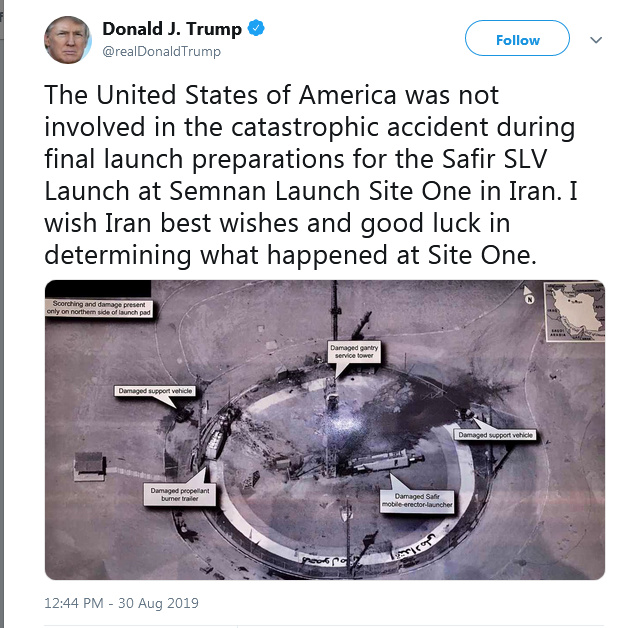As pictures from commercial satellites of a rocket’s smoking remains began to circulate, President Trump denied Friday on Twitterthat the United States was involved. It was an unusual message because the Iranian government had neither acknowledged the accident nor blamed the United States. His tweet ended with an apparent taunt: “I wish Iran best wishes and good luck in determining what happened” in the fiery accident.
But Mr. Trump also included in his tweet a high-resolution image of the disaster, immediately raising questions about whether he had plucked a classified image from his morning intelligence briefing to troll the Iranians. The president seemed to resolve the question on Friday night on his way to Camp David when he told reporters, “We had a photo and I released it, which I have the absolute right to do.”
[…]
Commercial satellite photographs and the far more detailed image that Mr. Trump released showed devastating damage at the Imam Khomeini Space Center. The rocket itself appeared to have disintegrated. White House and intelligence officials declined to say whether the image Mr. Trump tweeted came from his morning intelligence briefing, but other officials conceded it bore all of the markings of a spy-satellite image.
American officials have often accused Iran of conducting the launches, under the guise of its space program, to simulate the technology involved in deploying a conventional or nuclear warhead — an effort American officials have vowed to stop. In February, The New York Times reported that the Trump administration had accelerated a secret American program to sabotage both Iran’s missiles and its rockets.
Two previous attempts at launching satellites — on Jan. 15 and on Feb. 5 — failed. More than two-thirds of Iran’s satellite launches have failed over the past 11 years, a remarkably high number compared with the 5 percent failure rate worldwide.
Mr. Trump’s denial and the satellite image he released seemed meant to maximize Iran’s embarrassment over the episode.
[…]
If the accident was linked to a covert action by the United States — one that Mr. Trump would have been required to authorize in a presidential “finding” — he and other American officials would be required by law to deny involvement.
The laws governing covert actions, which stretch back to the Truman administration, focus on obscuring who was responsible for the act, not covering up the action itself. Most American presidents have fulfilled that requirement by staying silent about such episodes, but Mr. Trump does not operate by ordinary rules — and may have decided that an outright denial was his best course.
[…]
But it was Mr. Trump’s release of a satellite photograph that attracted the most discussion among intelligence officials. Several former officials noted that the upper right-hand corner, where the level of classification of the photograph would normally be denoted, was blacked out before Mr. Trump tweeted the image. That suggested a rushed effort by the United States to declassify it, presumably at Mr. Trump’s command. A glare on the photograph suggested someone may have used a cellphone to take a picture of the image as it was displayed on a tablet computer, which is how classified images are often shown to the president during security briefings.
[…]
David Schmerler, a senior research associate at the Middlebury Institute of International Studies, who closely examined the satellite imagery of Thursday’s blast, said there was no way to know if it was accidental or intentional.






